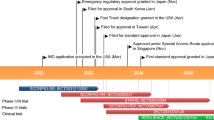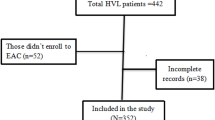Abstract
Objective: To characterise the pharmacokinetics of indinavir during different phases of the menstrual cycle in HIV-infected women.
Design: Open-label study.
Setting: The immunodeficiency clinic at Erie County Medical Center, Buffalo, New York.
Patients: Ten HIV-infected women were enrolled in the study. Eligibility criteria included an acceptable medical history, chemistry profile, complete blood count with differential, lymphocyte profile, urinalysis and history of a regular menstrual cycle. Patients had to be on a stable antiretroviral regimen that included indinavir 800mg taken every 8 hours.
Interventions: Blood sampling over an 8-hour period following an 800mg dose of indinavir during the menstrual, follicular and luteal phases of the menstrual cycle.
Main outcome measures: Pharmacokinetic parameters in ten HIV-infected women adherent with indinavir 800mg every 8 hours during the menstrual, follicular and luteal phases of the menstrual cycle. Serum estradiol and progesterone levels were also obtained during each menstrual cycle phase.
Results: The peak plasma concentration, plasma concentration 8 hours after administration of a given dose of indinavir, elimination half-life and oral clearance of indinavir were not significantly different across the menstrual cycle phases. Indinavir exposure varied among the female patients with some individuals having similar areas under the concentration-time curve (AUCs) during the three phases while others had notable differences in AUC. Maximum plasma indinavir concentrations were highest during the follicular phase in four subjects, highest during the luteal phase in two individuals, and highest during the menstrual phase in three patients.
Conclusions: No differences were found in indinavir pharmacokinetics during the menstrual cycle phases. Significant intra- and interpatient variability in indinavir pharmacokinetics were observed; however, indinavir exposure in women did not appear to be excessive compared with pharmacokinetic data obtained from prior studies conducted in men.





Similar content being viewed by others
References
Hader SL, Smith DK, Moore JS, et al. HIV infection in women in the United States. JAMA 2001: 92
Centers for Disease Control and Prevention. Mortality L285 slide series (through 1998) [online]. Available from URL: http://www.cdc.gov/hiv/graphics/mortalit.htm
Fletcher CV, Acosta EP, Strykowski, et al. Gender differences in human pharmacokinetics and pharmacodynamics. J Adolesc Health 1994; 15: 619–29
Giudicelli JF, Tillement JP Influence of sex on drug kinetics in man. Clin Pharmacokinet 1997; 2: 157–66
Harris RZ, Benet LZ, Schwarz JB. Gender effects in pharmacokinetics and pharmacodynamics. Drugs 1995; 50(2): 222–39
Bruguerolle B, Toumi M, Faraj F, et al. Influence of the menstrual cycle on theophylline pharmacokinetics in asthmatics. Eur J Clin Pharmacol 1990; 39: 59–61
Lew KH, Ludwig EA, Milad MA, et al. Gender-based effects on methylprednisolone pharmacokinetics and pharmacodynamics. Clin Pharmacol Ther 1993; 54: 402–14
Lane JD, Steege JF, Rupp SL, et al. Menstrual cycle effects on caffeine elimination in the human female. Eur J Clin Pharmacol 1992; 43: 543–6
Austin KL, Mather LE, Philpot CR, et al. Intersubject and dose-related variability after intravenous administration of erythromycin. Brit J Pharmacol 1980; 10: 273–9
Hunt CM, Westerkam WR, Stave GM. Effect of age and gender on the activity of human hepatic cyp3A. Biochem Pharmacol 1992; 44(2): 257–83
Cordaro JA, Morse GD, Bartos L, et al. Zidovudine pharmacokinetics in HIV-positive women during different phases of the menstrual cycle. Pharmacotherapy 1993; 13(4): 369–77
Kharasch ED, Russell M, Garton K, et al. Assessment of cytochrome P450 3A4 activity during the menstrual cycle using alfentanil as a noninvasive probe. Anesthesiology 1997; 87: 26–35
Kirkwood C, Moore A, Hayes P, et al. Influence of menstrual cycle and gender on alprazolam pharmacokinetics. Clin Pharmacol Ther 1991; 50: 404–9
Lammers SMM, Mainzer DEH, Breteler MHM. Do alcohol pharmacokinetics in women vary due to the menstrual cycle. Addiction 1995; 90: 23–30
Ebid A, Shelton M, Adams J, et al. Menstrual cycle and zidovudine pharmacokinetics in HIV-infected women. Clin Drug Invest 2001; 21: 715–26
Merck. Crixivan (indinavir) product information. Merck, 2001
Gulick RM, Mellors JW, Havlir D, et al. Treatment with indinavir, zidovudine, and lamivudine in adults with human immunodeficiency virus infection and prior antiretroviral therapy. New Engl J Med 1997; 337: 734–9
Jankelevich S, Mueller B, Smith S, et al. Long-term activity of indinavir/ZDV/3TC in HIV-1 infected children: results of a phase I/II study [abstract no. 231]. Abstracts of the 5th Conference on Retroviruses and Opportunistic Infections; Chicago, IL, 1998 Feb 1–8
Hirsch M, Steigbigel R, Staszewski S, et al. A randomized, controlled trial of indinavir, zidovudine, and lamivudine in adults with advanced human immunodeficiency virus type 1 infection and prior antiretroviral therapy. J Infect Dis 1999; 180(3): 659–65
Perrin L, Markowitz M, Calandra G, et al. An open treatment study of acute HIV infection with zidovudine, lamivudine, and indinavir sulfate [abstract no. 238]. Abstracts of the 4th Conference on Retroviruses and Opportunistic Infections; Washington DC, 1997 22–26 Jan
Stein DS, Fish DG, Bilello JA, et al. A 24-week open-label phase I/II evaluation of the HIV protease inhibitor MK-639 (indinavir). AIDS 1996; 10: 485–92
Yeh KC, Deutsch PJ, Haddix H, et al. Single-dose pharmacokinetics of indinavir and the effect of food. Antimicrob Agents Chemother 1998; 42(2): 332–8
Acosta EP, Henry K, Baken L, et al. Indinavir concentrations and antiviral effect. Pharmacotherapy 1999; 19(6): 708–12
Cox SR, Ferry JJ, Batts DH, et al. Delavirdine (D) and marketed protease inhibitors (PIs): pharmacokinetic (PK) interaction studies in healthy volunteers [abstract no. 327]. Abstracts of the 4th Conference on Retroviruses and Opportunistic Infections; Washington DC, 1997 Jan 22–26
Lin JH, Chiba M, Chen IW, et al. Sex-dependent pharmacokinetics of indinavir in vivo and in vitro evidence. Drug Metab Dispos 1996; 24(12): 1298–306
Balani SK, Arison BH, Mathai L, et al. Metabolites of L-735, 524, a potent HIV-1 protease inhibitor, in human urine. Drug Metab Dispos 1995; 23(2): 266–70
Balani SK, Woolf EJ, Hoagland VL, et al. Disposition of indinavir, a potent HIV-1 protease inhibitor, after an oral dose in humans. Drug Metab Dispos 1996; 24(12): 1389–94
Chiba M, Hensleigh M, Lin JH. Hepatic and intestinal metabolism of indinavir, an HIV protease inhibitor, in rat and human microsomes. Biochem Pharmacol 1997; 53: 1187–95
Chiba M, Hensleigh M, Nishme JA, et al. Role of cytochrome P450 3A4 in human metabolism of MK-639, a potent human immunodeficiency virus protease inhibitor. Drug Metab Dispos 1996; 24(3): 307–14
Condra JH, Holder DJ, Schleif WA, et al. Genetic correlates of in vitro resistance to indinavir, a human immunodeficiency virus type I protease inhibitor. J Virol 1996; 70(2): 8270–6
Koudriakova T, Iatsimirskaia E, Utkin I, et al. Metabolism of the human immunodeficiency virus protease inhibitors indinavirand ritonavir by human intestinal microsomes and expressed cytochrome P4503A4/3A5: mechanism-based inactivation of cytochrome P4503A by ritonavir. Drug Metab Disp 1998; 26(6): 552–61
Van Heeswijk RPG, Veldkamp AI, Hoetelmans RMW, et al. The steady-state plasma pharmacokinetics of indinavir alone and in combination with a low dose of ritonavir in twice daily dosing regimens in HIV-1 infected individuals. AIDS 1999; 13: F95–9
Burger DM, Hugen PW, Droste J, et al. Therapeutic drug monitoring of indinavir in treatment-naíve patients improves therapeutic outcome after 1 year: results from ATHENA [abstract no. 6.2a]. The 2nd International Workshop on Clinical Pharmacology of HIV Therapy; Noordwijk, The Netherlands 2001 Apr 2–4
Acosta EP, Kakuda TN, Brundage RC, et al. Pharmacodynamics of HIV-1 protease inhibitors. Clin Infect Dis 2000; 30 Suppl 2: S151–9
Murphy R, Sommadossi JP, Lamson M, et al. Antiviral effect and pharmacokinetic interaction between nevirapine and indinavir in persons with human immunodeficiency virus type 1. J Infect Dis 1999; 179: 1116–23
Piscitelli SC, Vogel S, Figg WD, et al. Alteration in indinavir clearance during interleukin-2 infusions in patients infected with the human immunodeficiency virus. Pharmacotherapy 1998; 18(6): 1212–6
Yeh KC, Stone JA, Carides AD, et al. Simultaneous investigation of indinavir nonlinear pharmacokinetics and bioavailability in healthy volunteers using stable isotope labeling technique: study design and model-independent data analysis. J Pharmaceut Sciences 1999; 88(5): 568–73
Woolf E, Au T, Haddix H, et al. Determination of L-735 524, an human immunodeficiency virus protease inhibitor, in human plasma and urine via high performance liquid chromatography with column switching. J Chromatogr 1995; 692: 45–52
Acknowledgements
At the time this study was conducted, Dr John Adams was funded as a fellow of the American College of Clinical Pharmacy. The development work on the indinavir assay was funded in part by an Adult AIDS Clinical Trials Group Pharmacology Support Laboratory grant from the National Institute of Allergy and Infectious Diseases.
Author information
Authors and Affiliations
Rights and permissions
About this article
Cite this article
Frost, C.E., Adams, J., Shelton, M. et al. Indinavir Pharmacokinetics during Different Phases of the Menstrual Cycle in HIV-Infected Women. Clin. Drug Investig. 22, 125–134 (2002). https://doi.org/10.2165/00044011-200222020-00007
Published:
Issue Date:
DOI: https://doi.org/10.2165/00044011-200222020-00007




